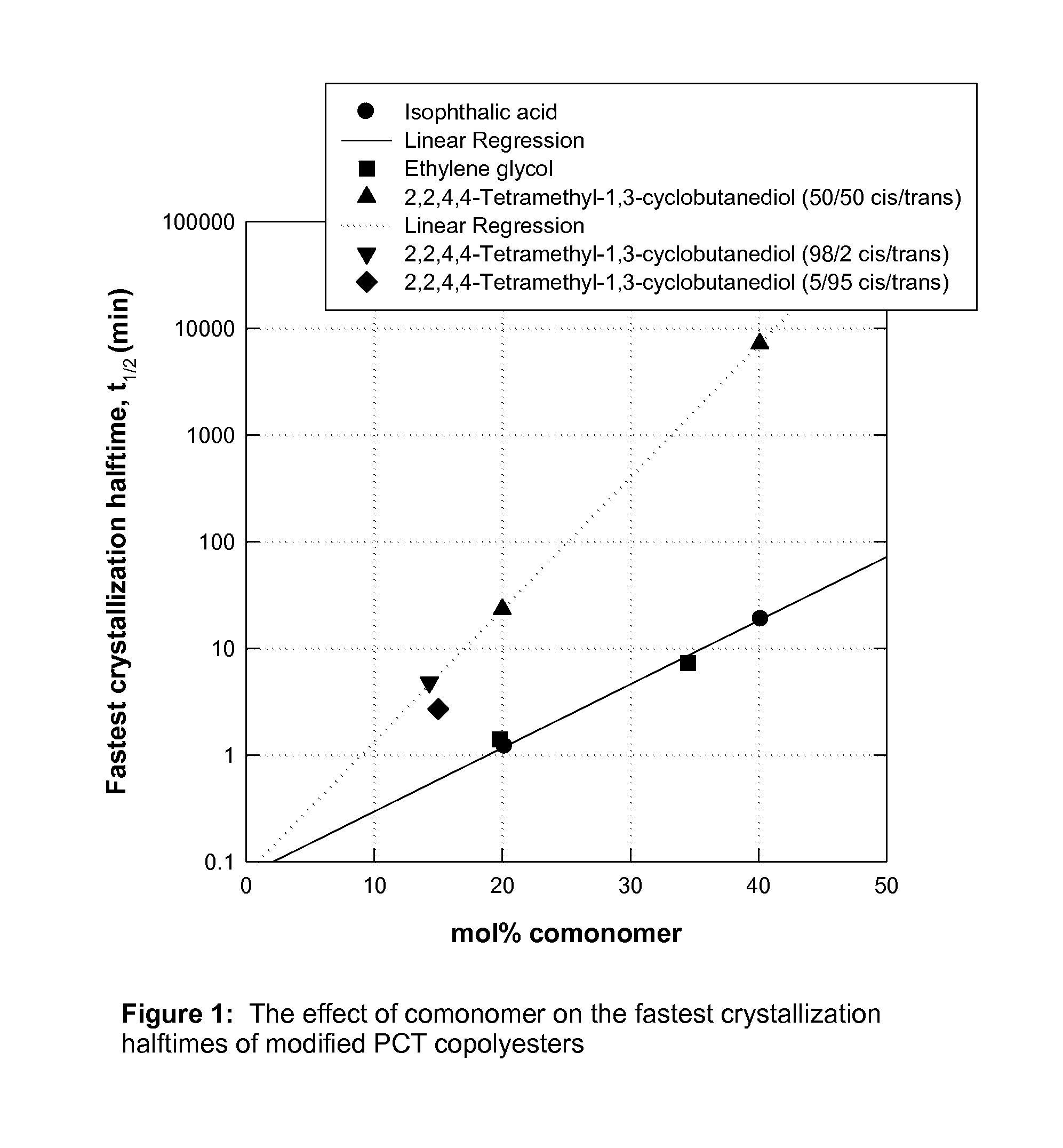Clear Semi-Crystalline Articles with Improved Heat Resistance
a semi-crystalline, heat-resistant technology, applied in packaging foodstuffs, packaging goods types, transportation and packaging, etc., can solve the problems of opacity in parts, difficult to mold or extrude even thin parts without thermal crystallization, and modified pct materials that provide little benefit in terms of heat-resistant performance, so as to improve heat-resistant performance and slow down the crystallization rate
- Summary
- Abstract
- Description
- Claims
- Application Information
AI Technical Summary
Benefits of technology
Problems solved by technology
Method used
Image
Examples
example 1
[0496]This example illustrates that TMCD is more effective at reducing the crystallization rate of PCT than EG or IPA.
[0497]A variety of copolyesters were prepared as described below. These copolyesters were all made with 200 ppm dibutyl tin oxide as the catalyst in order to minimize the effect of catalyst type and concentration on nucleation during crystallization studies. The cis / trans ratio of the 1,4-cyclohexanedimethanol was 31 / 69 while the cis / trans ratio of the 2,2,4,4-tetramethyl-1,3-cyclobutanediol is reported in Table 1.
[0498]For purposes of this example, the samples had sufficiently similar inherent viscosities thereby effectively eliminating this as a variable in the crystallization rate measurements.
[0499]Crystallization half-time measurements from the melt were made at temperatures from 140 to 200° C. at 10° C. increments and are reported in Table 1. The fastest crystallization half-time for each sample was taken as the minimum value of crystallization half-time as a f...
example 1a
[0508]This example illustrates the preparation of a copolyester with a target composition of 80 mol % dimethyl terephthalate residues, 20 mol % dimethyl isophthalate residues, and 100 mol % 1,4-cyclohexanedimethanol residues (28 / 72 cis / trans).
[0509]A mixture of 56.63 g of dimethyl terephthalate, 55.2 g of 1,4-cyclohexanedimethanol, 14.16 g of dimethyl isophthalate, and 0.0419 g of dibutyl tin oxide was placed in a 500-milliliter flask equipped with an inlet for nitrogen, a metal stirrer, and a short distillation column. The flask was placed in a Wood's metal bath already heated to 210° C. The stirring speed was set to 200 RPM throughout the experiment. The contents of the flask were heated at 210° C. for 5 minutes and then the temperature was gradually increased to 290° C. over 30 minutes. The reaction mixture was held at 290° C. for 60 minutes and then vacuum was gradually applied over the next 5 minutes until the pressure inside the flask reached 100 mm of Hg. The pressure inside ...
example 1b
[0510]This example illustrates the preparation of a copolyester with a target composition of 100 mol % dimethyl terephthalate residues, 20 mol % ethylene glycol residues, and 80 mol % 1,4-cyclohexanedimethanol residues (32 / 68 cis / trans).
[0511]A mixture of 77.68 g of dimethyl terephthalate, 50.77 g of 1,4-cyclohexanedimethanol, 27.81 g of ethylene glycol, and 0.0433 g of dibutyl tin oxide was placed in a 500-milliliter flask equipped with an inlet for nitrogen, a metal stirrer, and a short distillation column. The flask was placed in a Wood's metal bath already heated to 200° C. The stirring speed was set to 200 RPM throughout the experiment. The contents of the flask were heated at 200° C. for 60 minutes and then the temperature was gradually increased to 210° C. over 5 minutes. The reaction mixture was held at 210° C. for 120 minutes and then heated up to 280° C. in 30 minutes. Once at 280° C., vacuum was gradually applied over the next 5 minutes until the pressure inside the flask...
PUM
| Property | Measurement | Unit |
|---|---|---|
| Temperature | aaaaa | aaaaa |
| Temperature | aaaaa | aaaaa |
| Temperature | aaaaa | aaaaa |
Abstract
Description
Claims
Application Information
 Login to View More
Login to View More - R&D
- Intellectual Property
- Life Sciences
- Materials
- Tech Scout
- Unparalleled Data Quality
- Higher Quality Content
- 60% Fewer Hallucinations
Browse by: Latest US Patents, China's latest patents, Technical Efficacy Thesaurus, Application Domain, Technology Topic, Popular Technical Reports.
© 2025 PatSnap. All rights reserved.Legal|Privacy policy|Modern Slavery Act Transparency Statement|Sitemap|About US| Contact US: help@patsnap.com



